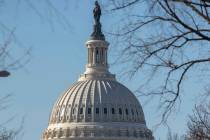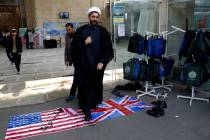The rest of the story on redistricting
The process of redistricting will have an overwhelming impact and enormous influence, since the result of redesigning congressional districts and local Assembly and Senate districts will help determine who can seek election, be elected and remain in office for the next 10 years.
Nevada, along with many other states, is moving through the redistricting process in preparation for the 2012 election. A major factor inherent in Nevada redistricting included the addition of a new fourth congressional district.
Since the 1960s, the boundaries of state legislative and federal congressional districts are required, by law, to be adjusted after each decennial census to provide reasonably equal population within districts across a state. This herein is the most important consideration when it comes to drawing the lines.
The League of Women Voters supports apportionment of congressional districts and elected legislative bodies based substantially upon population. The League of Women Voters also respectfully reminds the Nevada Legislature that the constitutional responsibility to reapportion resides in the legislative branch. So, as the grass-roots lobbyist for the League, I was disappointed that lawmakers were unable to complete the task while in session, throwing it to the courts.
The League of Women Voters of Las Vegas Valley, partnered with the "Grassroots Team," whose membership includes Dwayne Chesnut, Ph.D., Forrest Darby, Carol Chesnut and Mike Selvage. The Grassroots Team presented maps for consideration based upon fairness, competitive elections and easily identifiable boundaries. The final maps created by this team were different than the maps presented by both the Democratic and Republican leadership.
The Grassroots Team posted two congressional district plans. The first plan includes a detailed report on voting age population, registration and voter turnout for each proposed district. Using 2010 voter turnout as a measure, CD4 was 48.3 percent Democratic and 35.5 percent Republican, which counterbalances CD2 which is 34.6 percent Democratic and 48.5 percent Republican. CD1 and CD3 both have a Democratic edge, but nevertheless are competitive.
This proposal is fair to both parties, although it does have the effect of packing Democrats into the new fourth district.
The second plan basically spreads the Democratic edge evenly among the three Southern Nevada districts, and is therefore the most neutral with respect to party affiliation. This is a good fit with the League's nonpartisan position, and would provide three competitive districts in Southern Nevada. The League decided to support this plan in court.
In Nevada, "equal population" strictly means that each of our four congressional districts, our 21 state Senate districts, and our 42 Assembly districts should have, respectively, about 675,138 people, 128,598 people and 64,299 people, respectively. The League of Women Voters strongly supports this bedrock principle of apportionment -- equal population -- but only within the limited deviations from strict equality established by case law.
The U.S. Supreme Court decision in Abrams v. Johnson (1997) allows the largest and smallest congressional districts to deviate from each other by up to 0.35 percent of the ideal, relaxing the one person limit previously mandated in Karcher v. Daggett (1983). The court also found in Brown v. Thomson (1983) that population differences of up to 10 percent in the apportionment of state legislative districts falls within "the category of minor deviations."
Using strict equality is unduly restrictive and is often used as an excuse to disguise gerrymandering, to which the League is opposed.
It must be noted that Nevada has state-of-the-art redistricting software available and accessible for public use. The Grassroots Team used this technology to construct their maps. The Legislative Counsel Bureau posts the public proposals on the state website NELIS. Therefore, everyone may look at all the maps drawn up by residents, legislators, and those of the special masters alike.
It is understandable that political parties want political leverage when redistricting; nevertheless, leverage is not a license to forgo sensible political subdivisions based upon population. Legislators should be reminded that the key to winning elections is always founded in getting out the vote and ensuring that public opinion is heard, on the record and part of the process.
New maps drawn by special masters have been determined and the Nevada Supreme Court will weigh in as to their integrity and viability. The League of Women Voters and the Grassroots Team have appreciated the opportunity to participate in the 2011 redistricting process as Nevadans.
Sam King is a lobbyist and past president for the League of Women Voters of Nevada.























